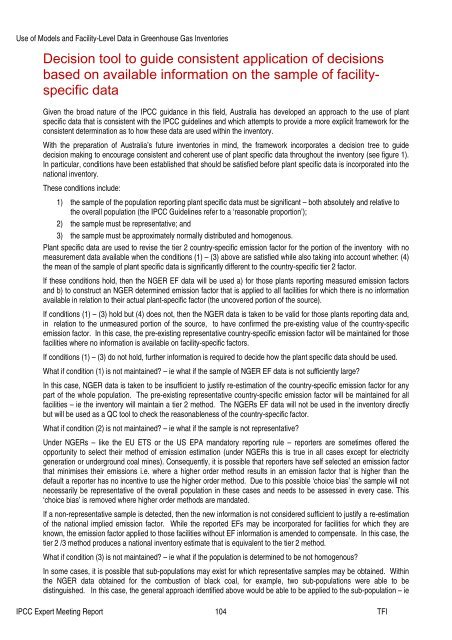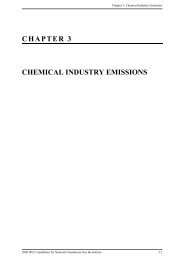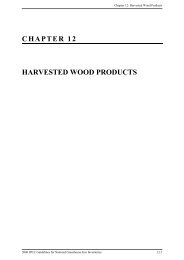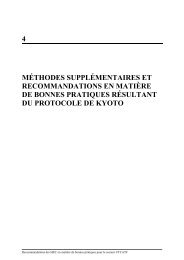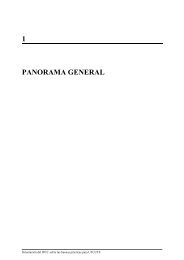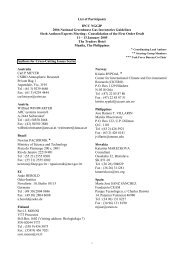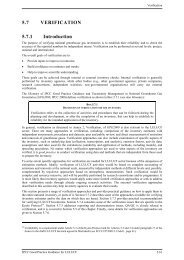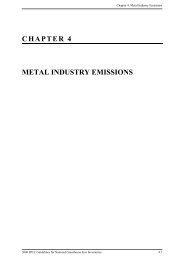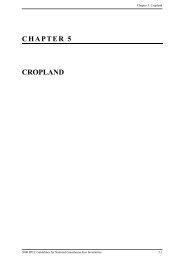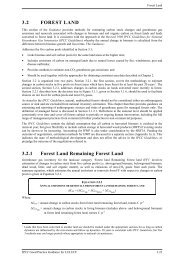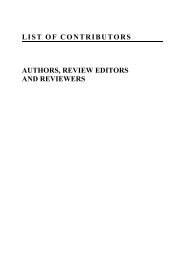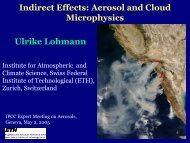Use of Models and Facility-Level Data in Greenhouse Gas Inventories
Use of Models and Facility-Level Data in Greenhouse Gas Inventories
Use of Models and Facility-Level Data in Greenhouse Gas Inventories
You also want an ePaper? Increase the reach of your titles
YUMPU automatically turns print PDFs into web optimized ePapers that Google loves.
<strong>Use</strong> <strong>of</strong> <strong>Models</strong> <strong>and</strong> <strong>Facility</strong>-<strong>Level</strong> <strong>Data</strong> <strong>in</strong> <strong>Greenhouse</strong> <strong>Gas</strong> <strong>Inventories</strong><br />
Decision tool to guide consistent application <strong>of</strong> decisions<br />
based on available <strong>in</strong>formation on the sample <strong>of</strong> facilityspecific<br />
data<br />
Given the broad nature <strong>of</strong> the IPCC guidance <strong>in</strong> this field, Australia has developed an approach to the use <strong>of</strong> plant<br />
specific data that is consistent with the IPCC guidel<strong>in</strong>es <strong>and</strong> which attempts to provide a more explicit framework for the<br />
consistent determ<strong>in</strong>ation as to how these data are used with<strong>in</strong> the <strong>in</strong>ventory.<br />
With the preparation <strong>of</strong> Australia’s future <strong>in</strong>ventories <strong>in</strong> m<strong>in</strong>d, the framework <strong>in</strong>corporates a decision tree to guide<br />
decision mak<strong>in</strong>g to encourage consistent <strong>and</strong> coherent use <strong>of</strong> plant specific data throughout the <strong>in</strong>ventory (see figure 1).<br />
In particular, conditions have been established that should be satisfied before plant specific data is <strong>in</strong>corporated <strong>in</strong>to the<br />
national <strong>in</strong>ventory.<br />
These conditions <strong>in</strong>clude:<br />
1) the sample <strong>of</strong> the population report<strong>in</strong>g plant specific data must be significant – both absolutely <strong>and</strong> relative to<br />
the overall population (the IPCC Guidel<strong>in</strong>es refer to a ‘reasonable proportion’);<br />
2) the sample must be representative; <strong>and</strong><br />
3) the sample must be approximately normally distributed <strong>and</strong> homogenous.<br />
Plant specific data are used to revise the tier 2 country-specific emission factor for the portion <strong>of</strong> the <strong>in</strong>ventory with no<br />
measurement data available when the conditions (1) – (3) above are satisfied while also tak<strong>in</strong>g <strong>in</strong>to account whether: (4)<br />
the mean <strong>of</strong> the sample <strong>of</strong> plant specific data is significantly different to the country-specific tier 2 factor.<br />
If these conditions hold, then the NGER EF data will be used a) for those plants report<strong>in</strong>g measured emission factors<br />
<strong>and</strong> b) to construct an NGER determ<strong>in</strong>ed emission factor that is applied to all facilities for which there is no <strong>in</strong>formation<br />
available <strong>in</strong> relation to their actual plant-specific factor (the uncovered portion <strong>of</strong> the source).<br />
If conditions (1) – (3) hold but (4) does not, then the NGER data is taken to be valid for those plants report<strong>in</strong>g data <strong>and</strong>,<br />
<strong>in</strong> relation to the unmeasured portion <strong>of</strong> the source, to have confirmed the pre-exist<strong>in</strong>g value <strong>of</strong> the country-specific<br />
emission factor. In this case, the pre-exist<strong>in</strong>g representative country-specific emission factor will be ma<strong>in</strong>ta<strong>in</strong>ed for those<br />
facilities where no <strong>in</strong>formation is available on facility-specific factors.<br />
If conditions (1) – (3) do not hold, further <strong>in</strong>formation is required to decide how the plant specific data should be used.<br />
What if condition (1) is not ma<strong>in</strong>ta<strong>in</strong>ed? – ie what if the sample <strong>of</strong> NGER EF data is not sufficiently large?<br />
In this case, NGER data is taken to be <strong>in</strong>sufficient to justify re-estimation <strong>of</strong> the country-specific emission factor for any<br />
part <strong>of</strong> the whole population. The pre-exist<strong>in</strong>g representative country-specific emission factor will be ma<strong>in</strong>ta<strong>in</strong>ed for all<br />
facilities – ie the <strong>in</strong>ventory will ma<strong>in</strong>ta<strong>in</strong> a tier 2 method. The NGERs EF data will not be used <strong>in</strong> the <strong>in</strong>ventory directly<br />
but will be used as a QC tool to check the reasonableness <strong>of</strong> the country-specific factor.<br />
What if condition (2) is not ma<strong>in</strong>ta<strong>in</strong>ed? – ie what if the sample is not representative?<br />
Under NGERs – like the EU ETS or the US EPA m<strong>and</strong>atory report<strong>in</strong>g rule – reporters are sometimes <strong>of</strong>fered the<br />
opportunity to select their method <strong>of</strong> emission estimation (under NGERs this is true <strong>in</strong> all cases except for electricity<br />
generation or underground coal m<strong>in</strong>es). Consequently, it is possible that reporters have self selected an emission factor<br />
that m<strong>in</strong>imises their emissions i.e. where a higher order method results <strong>in</strong> an emission factor that is higher than the<br />
default a reporter has no <strong>in</strong>centive to use the higher order method. Due to this possible ‘choice bias’ the sample will not<br />
necessarily be representative <strong>of</strong> the overall population <strong>in</strong> these cases <strong>and</strong> needs to be assessed <strong>in</strong> every case. This<br />
‘choice bias’ is removed where higher order methods are m<strong>and</strong>ated.<br />
If a non-representative sample is detected, then the new <strong>in</strong>formation is not considered sufficient to justify a re-estimation<br />
<strong>of</strong> the national implied emission factor. While the reported EFs may be <strong>in</strong>corporated for facilities for which they are<br />
known, the emission factor applied to those facilities without EF <strong>in</strong>formation is amended to compensate. In this case, the<br />
tier 2 /3 method produces a national <strong>in</strong>ventory estimate that is equivalent to the tier 2 method.<br />
What if condition (3) is not ma<strong>in</strong>ta<strong>in</strong>ed? – ie what if the population is determ<strong>in</strong>ed to be not homogenous?<br />
In some cases, it is possible that sub-populations may exist for which representative samples may be obta<strong>in</strong>ed. With<strong>in</strong><br />
the NGER data obta<strong>in</strong>ed for the combustion <strong>of</strong> black coal, for example, two sub-populations were able to be<br />
dist<strong>in</strong>guished. In this case, the general approach identified above would be able to be applied to the sub-population – ie<br />
IPCC Expert Meet<strong>in</strong>g Report 104 TFI


